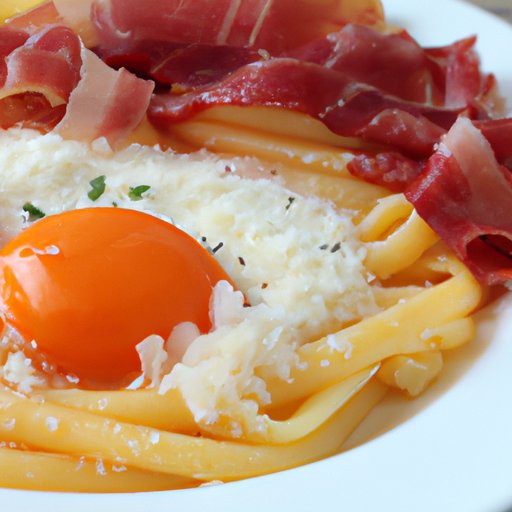
Introduction
Carbonara sauce is a creamy, bacon and egg-based pasta sauce that has become a popular dish worldwide. In this article, we will provide a comprehensive guide on how to make carbonara sauce from scratch with all the necessary ingredients and measurements. Additionally, we’ll dive into the history and cultural significance of the dish, explore ingredient sourcing, and offer creative variations for the adventurous cook.
Recipe-based Article
Carbonara sauce is a delicious, indulgent pasta sauce that has a rich and velvety texture. It’s made with pancetta or bacon, eggs, Parmesan cheese, and black pepper. To make this sauce, you will need the following ingredients:
- 1 lb pasta
- 3 egg yolks
- 1 cup grated Parmesan cheese (divided)
- 1/2 cup pancetta or bacon, chopped
- 1/4 cup heavy cream
- 1/4 teaspoon salt
- 1/2 teaspoon black pepper
Now let’s dive into the step-by-step recipe:
- Bring a large pot of salted water to a boil. Add the pasta and cook until al dente, stirring occasionally, about 10-12 minutes.
- While the pasta cooks, in a separate bowl, whisk together the egg yolks, 1/2 cup grated Parmesan cheese, cream, salt, and pepper.
- In a large skillet, cook pancetta or bacon over medium-high heat until crisp, stirring occasionally. Remove from heat.
- When the pasta is done, reserve 1 cup of the cooking liquid, then drain the pasta and return to the pot.
- While the pasta is still hot, add the egg mixture and pancetta to the pot and stir rapidly to coat the pasta evenly with the sauce.
- If the sauce is too thick, add the reserved cooking liquid, a little bit at a time to thin it out to your desired consistency.
- Serve immediately, topped with the remaining 1/2 cup grated Parmesan cheese and extra black pepper.
Cooking the sauce at a low temperature guarantees that the egg sauce will not curdle, and the pancetta or bacon will be crispy.
If you’re wondering how to keep the carbonara sauce hot, the trick is simple. Remove the skillet from heat before the eggs start to scramble when the pan’s still hot.
Historical Account
The origin of carbonara sauce is highly debated, with many stories regarding its creation. However, most accounts point to the dish’s emergence after World War II, where American soldiers brought bacon and eggs to Italy. Italians then used the ingredients to create a new flavor for their pasta dishes.
Carbonara sauce’s cultural relevance lies in its simplicity and popularity worldwide. Today, it serves as a widespread dish that many cultures identify with Italy and its rich culinary history.
Fun fact: Carbonara sauce recipes do not involve cream, contrary to popular belief. However, modern versions in America and other countries sometimes use cream to improve the sauce’s consistency and creaminess.
Ingredient-focused Article
Carbonara sauce is a simple and straightforward recipe that requires high-quality, fresh ingredients. The sauce’s richness primarily comes from the creamy egg yolks and freshly grated Parmesan cheese. Furthermore, sourcing the right pancetta or bacon is paramount to the success of any carbonara sauce recipe.
Pancetta is an Italian version of bacon that has an unsmoked, salty flavor. It creates more delicate carbonara sauce than traditional bacon. If you don’t have pancetta, you can use bacon instead, and it will still be delicious.
When buying pancetta, ask your deli person to cut it into small cubes. It’ll make it easier to fry and incorporate into the sauce.
Similarly, use freshly grated Parmesan cheese rather than canned cheese. It has a richer flavor and melts more evenly into the sauce.
Creative Variations
For those who want to experiment with different variations of carbonara sauce, numerous recipes involve variations of this classic pasta dish. Here are a few suggestions:
- Adding garlic or onions for a flavor kick
- Using different kinds of pasta like linguine, rigatoni or fettuccine
- Adding mushrooms or peas for extra color and texture
- Using white sauce instead of egg yolk for the vegan version
- Substituting the egg yolks for heavy cream for a different take on the classic carbonara sauce.
Feel free to experiment with the suggested variations to find your perfect carbonara sauce recipe.
Cultural Significance
Carbonara sauce is primarily associated with Italy, where they are originally made. Roman cuisine includes various variations of Carbonara, such as pasta alla Gricia, which is a no- egg version of Carbonara sauce.
Carbonara sauce’s impact can reach beyond its traditional boundaries, making it a popular option for Italy’s food joints worldwide. It’s a dish that transcends borders and brings people together around the dinner table.
Conclusion
Carbonara sauce is a classic pasta dish that is easy to make, looks beautiful and tastes great. With this guide and recipe, we hope you now feel equipped and confident enough to prepare this in your own kitchen.
Experiment with different ingredients, such as seasoning, the pasta noodles, or try different variations of this classic sauce, the possibilities are endless.
Food is all about experimenting with different flavors, techniques, and creating a beautiful memory around the dinner table. Buon appetito.





